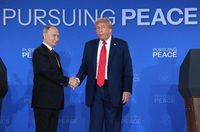The high-stakes Alaska summit between U.S. President Donald Trump and Russian President Vladimir Putin, held before August 20, 2025, may well be remembered as a pivotal moment in the ever-shifting landscape of global power. While the world watched for progress on the grinding war in Ukraine, the meeting's true significance lay deeper: a strategic gambit by Trump to break the growing China-Russia axis and reshape the 21st-century balance of power. According to Nexstar Media Inc., the summit marked a bold attempt to reverse a U.S. policy that, perhaps unintentionally, had driven two historic rivals—Russia and China—into a partnership now seen as the gravest threat to American preeminence since the Cold War.
Trump’s intentions were anything but subtle. In a Fox News interview immediately after the summit, he criticized his predecessor’s policies, stating, “He [Biden] did something that was unthinkable. He drove China and Russia together. That’s not good. If you are just a minor student of history, it’s the one thing you didn’t want to do.” This blunt assessment captured the anxiety in Washington: punitive measures against Russia, especially after its 2022 invasion of Ukraine, had not isolated Moscow as hoped. Instead, they had pushed Putin closer to Beijing, creating a two-against-one dynamic that left America facing a formidable alliance.
For decades, U.S. grand strategy was grounded in keeping Moscow and Beijing apart. Richard Nixon’s 1972 outreach to China was less about friendship and more about exploiting the Sino-Soviet split to contain Soviet power. This approach, as outlined in Nexstar Media Inc., helped tip the Cold War in the West’s favor. But recent years have upended that logic. Sanctions on Russia, meant to cripple its economy, instead strengthened the China-Russia partnership. China, hungry for resources, has become the main beneficiary: it now enjoys discounted, long-term Russian energy supplies and has secured a financial lifeline as Russia parks export earnings in Chinese banks. As the Ukraine war drags on, Russia’s resilience and military initiative have only increased Putin’s leverage, making any ceasefire unlikely unless it’s on his terms.
The Alaska summit, then, was more than a bilateral encounter—it was a signal that the U.S. recognized the need for a strategic reset. Trump’s calculus was clear: end the Ukraine war, ease tensions with Russia, and prevent a durable Sino-Russian alliance that could accelerate America’s relative decline. As Nexstar Media Inc. notes, “If he can begin to pry Moscow away from Beijing—or even sow just enough mistrust to prevent a durable Sino-Russian alliance—he will have altered the trajectory of world politics.”
But the summit also spotlighted nuclear arms control, a bilateral issue of existential importance. As reported by Daily News Egypt, both Trump and Putin control more than 90 percent of the world’s nuclear warheads. The Alaska talks revived critical areas of convergence: reaffirming the January 2022 P5 UN Security Council statement that “a nuclear war cannot be won and must never be fought,” voluntarily maintaining New START limits even beyond the treaty’s expiry, refraining from explosive nuclear testing, freezing non-strategic nuclear weapons, and acknowledging the destabilizing risks of unconstrained missile defense. These discussions, though overshadowed by the Ukraine crisis, may prove vital in preventing a new arms race.
Yet, on Ukraine itself, the summit produced no immediate breakthroughs. According to The Conversation, the negotiations yielded little detail on progress, and no deal was struck. Reports suggested Trump had agreed to Putin’s call for Ukrainian territorial concessions and a move toward a conclusive peace agreement, rather than an immediate ceasefire—a stance that alarmed European capitals. Germany, France, and the UK remain steadfast in backing Ukraine’s resistance, while Ukrainian President Volodymyr Zelenskyy, at a follow-up White House meeting on August 18, 2025, secured only vague promises of security guarantees from Trump and EU allies.
Putin’s demands have remained consistent: U.S. guarantees that Kyiv will not join NATO and implicit recognition of territories occupied by Russia since the war began. For Putin, the Alaska summit offered multiple gains—restoring dialogue with Washington, breaking international isolation, sidelining Western Europe, and even beginning to ease some U.S. sanctions in sectors like AI services and civil aviation, as detailed by Daily News Egypt.
For Trump, the summit was also about personal legacy. His pursuit of the Nobel Peace Prize was front and center, with nominations from Pakistan, Israel, and Cambodia in the preceding months. As Daily News Egypt observed, Trump’s actions on the international stage “suggest a clear priority: securing the Nobel Peace Prize.” Beyond symbolism, Trump harvested three key gains: access to Russia’s rare raw materials, constraining Europe’s role in global security, and driving a wedge between Moscow and Beijing.
The warmth between the two leaders was evident—Putin, typically rigid, appeared unusually relaxed during the red-carpet welcome at Anchorage Air Base. Such chemistry raised hopes, and fears, of a dramatic reorientation in world politics. Was this the beginning of an “overturning” of the post–Cold War order? For Washington, the summit was meant to focus on Ukraine and arms control; for Moscow, it was a comprehensive reset; for Trump, it was all of these, plus a stage for personal glory and geopolitical maneuvering.
European powers, meanwhile, were left uneasy. Trump’s willingness to consider Ukrainian territorial concessions and his apparent prioritization of U.S.-Russia relations over European concerns sparked alarm. Zelenskyy’s public stance remains firm—no concessions to Russia, and faith that Western arms can help Ukraine secure a better outcome. But the reality is grim: as The Conversation put it, “the solution to the Russia-Ukraine war appears to be closer to what Russia is willing to accept than Ukraine.” Trump’s concerns, it seems, lie more with the broader strategic contest with China than with the fate of Ukraine itself.
At the heart of the summit was a recognition of the limits of old approaches. The Ukraine war has drained U.S. focus, even as China expands its influence in the Indo-Pacific—the true theater of 21st-century geopolitics. Trump’s gamble is that by resetting relations with Russia, the U.S. can refocus on countering China and prevent the formation of a Eurasian powerhouse that could challenge American supremacy. Critics may call it appeasement, but the echoes of Nixon’s outreach to Mao are unmistakable: exploit rivalries, keep adversaries apart, and preserve U.S. dominance.
As the dust settles on the Alaska summit, one thing is clear: the world stands at a crossroads. The choices made in Anchorage may shape the next chapter of global order, for better or worse. Whether Trump’s risky reset succeeds or backfires, the stakes could hardly be higher.




